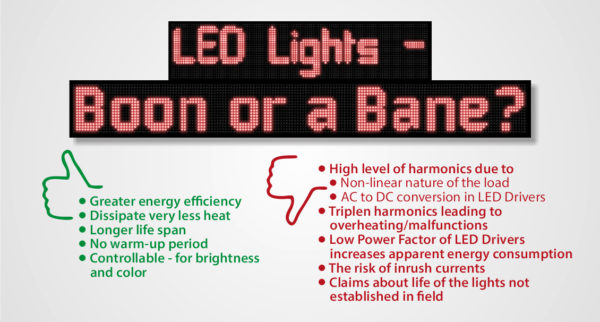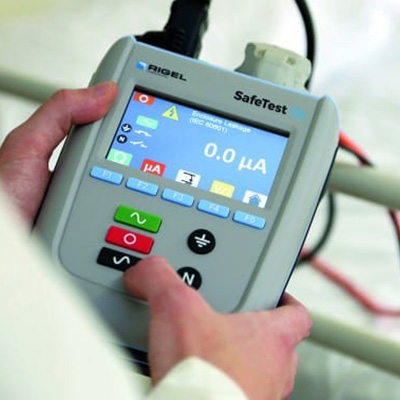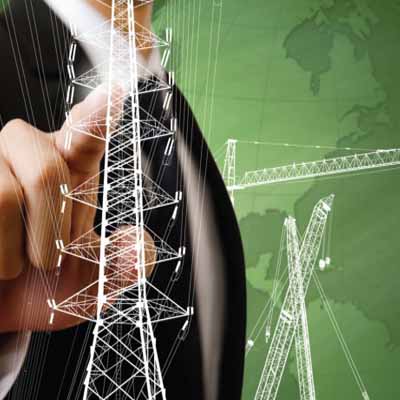Published On: Oct 05, 2018
Effects of increasing use of LED lights on Power Quality and the ways to address it!
|
High energy efficiency is driving large scale adoption of LED lights across every sector – households, commercial establishments, industries and public places. However, LED lights, known for their energy saving quality, are no exception to causing poor power quality when widely used with little or no consideration to the electrical environment. To promote the use of LED lights on large scale, the Government of India has started UJALA (Unnat Jyoti by Affordable LEDs for All) programme and it has practically transformed the LED lighting industry in India. This program made LED lights available at affordable prices, like never before. Since 2014, the demand for LED lights has gone up by almost 50 times growing at the rate of 17-18% annually. As LED lights gain traction and become the mainstay, there are several important considerations one must pay attention to before adopting LED lights on a large-scale. |
EFFECT OF INCREASING USE OF LED LIGHTS ON POWER QUALITY
|
With all the benefits mentioned above, use of LED lighting has increased dramatically over the past five years. Many industries have replaced hundreds to thousands of high bay LED lights at their facilities. Today, LED lights are the default choice for most greenfield facilities. However, the impact of large-scale adoption of LED Lights is often not considered to the extent that is required. Factors due to which LEDs adversely affect the power quality include Conversion of AC to DC |
Triplen Harmonics
LED lights can cause Triplen harmonics and they have to be considered separately as system response to triplen harmonics is different than other harmonics. These harmonics are the odd multiples of the third harmonic (h = 3, 9, 15, 21, . . .). Magnitude of these currents on the 3 phases are additive in the neutral. This can lead to very large currents circulating in the neutral and cause issues like overheating, misbehaving equipment and can also lead to fire.
Low power factor of LED driver
LED drivers with a low power factor reflect harmonics back to the mains. Increasing number of high power LED lights increases a risk of electrical pollution across the mains.
Inrush Current
LED lighting with compensated power factor can cause high inrush current. This can cause damage and malfunction of equipment.
Harmonics generated is non-significant when a number of LED lights is less as they consume very little power. When an electrical circuit has a very high density of LED lights connected to a single power source, it may create significant harmonic distortion and power quality issues.
To measure the diversity factors to know the impact of a large number of LED lamps on power quality, Diversity factor[3] is defined as – Df = Vector sum of current harmonic / Arithmetic sum of current harmonic
High diversity factor indicates high harmonic injection to the system.
Harmonics can result into high electromagnetic interference and finally could result in failure of equipment, incurring huge costs for the company. It is therefore important to maintain caution in large-scale adoption of LEDs, as the advantages earned in terms of energy savings could be washed away with adverse impact on the Power Quality in electrical network.
RECOMMENDATIONS FOR INSTALLATION OF LED LIGHTS TO MINIMIZE THE IMPACT ON POWER QUALITY ISSUES
Given below, is a set of key recommendations in procurement and installation of LED Lights and Drivers:
Select LED Lights as specified by the Standards
- THD (Total Harmonic Distortion) should be less than 15% for LED bulbs
- Color temperature of bulbs should be within the range of 5000-6000K
- Power Factor of the LED bulb should be more than 0.9
- The average of initial power consumed by the LED lamps in the measured sample shall not exceed the rated power by more than 7.5 %.
- Power Factor correction of LED Drivers is often achieved with external de-tuned reactive compensation system. The international standard EN 61000-3-2 therefore requires that LED drivers of 25W and higher should come with Power Factor correction.
- Output regulation of ±5% or more is considered to be good quality LED driver
- Over-voltage, over-current, over-temperature and short-circuit protection are commonly provided in good quality LED drivers
- LED Drivers must comply with the global energy regulations
- ‘Driver’ testing specifications in LED systems are given in IS 15885 Part 2. Specific norms of electrical parameters have been specified in 16102- Part 2.
Other Practical Measures to minimize the impact of LEDs on Power Quality issues
- Experiments have shown that different models of LED lights used together can reduce diversity factor and harmonics. Furthermore, CFLs with LEDs used together further reduce the diversity factor and hence the harmonic distortion. It is therefore recommended to use both LED and CFLs for lighting a large area like industrial plant to reduce power quality issues.
- Installation of harmonic filters is desirable to mitigate the risks of harmonic pollution
- Use inrush current calculations to decide the number of LED drivers that can be safely connected to a circuit breaker
CONCLUSION
Given the need to be energy efficient, the trend of LED lights replacing the traditional lighting systems will continue to see high levels of growth in the future. Whether the LED lights turn to be a boon or a bane will then largely depend on the awareness and corrective measures taken by the consumers to go beyond the visible advantages in choosing LED Lights and also focus on minimising the largely invisible adverse impact on the Power Quality in their electrical network.
REFERENCES
- http://cprindia.org/news/6527
- http://www.pe.org.pl/articles/2012/11a/61.pdf
- Electricity consumption in Indian homes a journey towards UJALA
- http://www.iaeng.org/publication/IMECS2014/IMECS2014_pp683-686.pdf
- LED and Power Quality Matters
- LED Interference Issues
- http://www.elcomaindia.com/wp-content/uploads/ELCOMA-Mumbai-Jan-05-2012-Nirupam-Sahay-LED-Lighting-scena.pdf
- http://cired.net/publications/cired2015/papers/CIRED2015_1483_final.pdf









